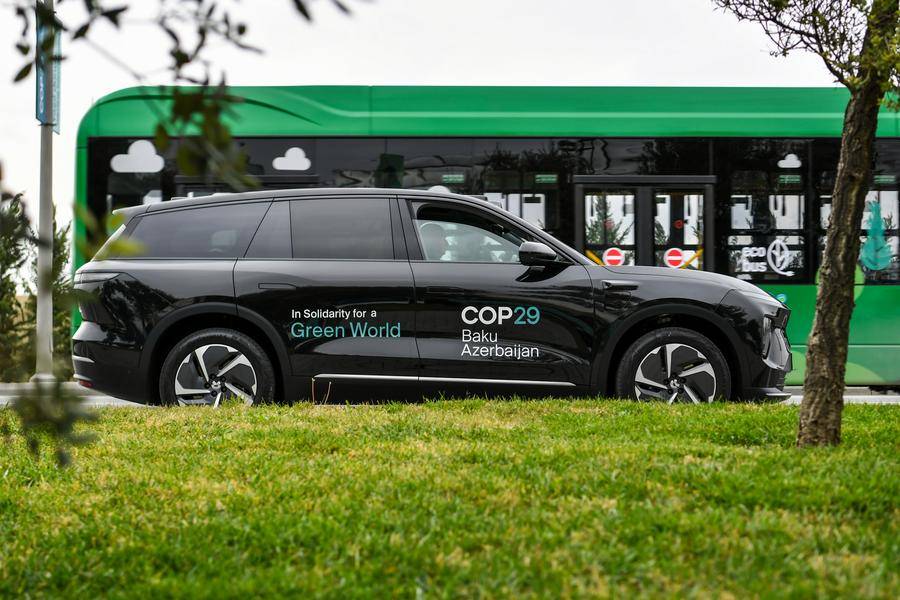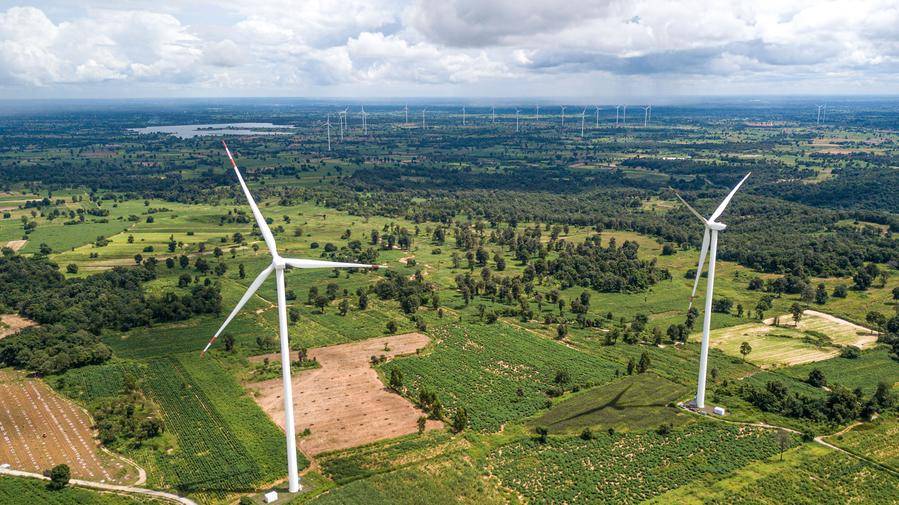Tackling Climate Change: China in Action

The twin pillars of China’s climate policy are strengthening international solidarity and cooperation and ensuring harmonious co-existence with nature.
Record-breaking hot days worldwide in 2023 have made people realize that global warming is no longer merely a warning, but a grim reality. The most recent alert came from Spain’s catastrophic flooding in late October. Today, not only temperatures, but also precipitation patterns are drastically changing as a result of global warming.
According to the State of Global Water Resources 2023 report released by the World Meteorological Organization recently, as a result of rising temperatures, the hydrological cycle has accelerated, and the world is facing growing problems of either too much or too little water. A warmer atmosphere holds more moisture, which can cause heavy rainfall. Spain’s flooding is a case in point.
Last year, the COP28 UN Climate Change Conference in Dubai, the UAE, was the largest of its kind, demonstrating the world’s determination for green and low-carbon transition. The conference concluded with the first ever Global Stocktake (GST), a mid-term review of the progress made toward the goals of 2015 Paris Agreement. The GST showed that progress was too slow across all areas of climate action, from reducing greenhouse gas emissions to strengthening resilience to a changing climate, to getting financial and technological support to vulnerable nations. Countries responded by agreeing to speed up action across all areas by 2030. This includes speeding up transition from fossil fuels to renewable energy, such as wind and solar power.
A major task of the 2024 UN Climate Change Conference (COP29) in Baku, Azerbaijan, was to agree on a post-2025 climate finance target and make preparations for a new round of nationally determined commitments to be submitted by the member states by February 2025.
China’s stance
Where does China stand in all of this? In November China released the 2024 Report on China’s Policies and Actions for Addressing Climate Change, explaining its stance. The report says while China is steadfast in implementing the United Nations Framework Convention on Climate Change (UNFCCC), which marks its 30th anniversary this year, and the Paris Agreement, multilateralism is the only way to address common challenges.
There should be agreement on a “new collective quantified goal” (NCQG) on climate finance, and also support in technology and capacity building. For funding, the primary task is to ensure developed countries fulfill their obligations of providing and mobilizing funding for developing countries and guaranteeing funding transparency in accordance with the UNFCCC and the Paris Agreement. In particular, developed countries should fulfill their commitment of contributing $100 billion annually by 2025 and come up with a roadmap for doubling adaptation finance, providing sufficient, predictable and sustainable financial support to developing countries under the NCQG. China stresses the importance of the principle of common but differentiated responsibilities and respective capabilities in the light of different national circumstances. Climate funding cannot add debts to developing countries.
China also calls for strengthening international solidarity and cooperation. In recent years, some countries have practiced unilateral protectionism in the name of climate change. They built green barriers, disrupted free trade and investment regarding green products and industries, and hindered the transfer and spreading of low-carbon technology. These moves have severely undermined mutual trust and capacity of the world as a whole to cope with climate change, and will increase unnecessary negative spillover effects and the cost for all countries to fulfill their commitments. Efforts should be made to talk parties out of unilateral measures, including that by the United States and some European countries, strengthen solidarity and cooperation, and bring positive energy and favorable conditions for multilateral climate action.

Also, pragmatic measures should be taken to promote green transition in a fair manner. Effective climate action has to be rooted in the realities of each country. Only by respecting each country’s differing circumstances, development stages and capacities, and promoting transition in a fair manner under the framework of sustainable development and poverty reduction, can the climate ambition be achieved. Developed countries should take the lead in reducing emissions but the overall Paris Agreement should be implemented, rather than merely setting emission reduction targets.
Han Wenya, a senior expert with the Policy Research Center for Environment and Economy, China’s Ministry of Ecology and Environment (MEE), stressed that the principle of common but differentiated responsibilities should be respected by all member states. Han was critical of practices ignoring the principle and implementing trade protectionism in the name of climate action, like imposing trade barriers or tariffs on green and low-carbon products like electric vehicles. “[Such practices] jeopardize the multilateral trade system, and ultimately hinder international cooperation in addressing climate change,” Han told China Today.
On the sideline of COP29, a seminar titled Synergy of Global Economy, Climate and Trade Policy, was hosted. Han observed that fair, reasonable and convenient policies for green trade facilitate optimal allocation of resources worldwide and sustainable development of the world economy. “Synergy of industry, climate and trade policy is conducive to innovation of green and low-carbon technology, the transformation of traditional industries, as well as the development of emerging green industries.”
China in action
Xia Yingxian, head of the Department of Climate Change at MEE, has described China as “a country of action in climate change.”
Ensuring harmonious coexistence of man and nature is an important part of China’s modernization drive. President Xi Jinping has announced that China will peak carbon dioxide emissions by 2030 and achieve carbon neutrality by 2060, which means China will realize carbon peaking and carbon neutrality in the shortest period of time in history. In July, the Communist Party of China’s leadership pledged efforts at the third plenary session of the 20th CPC Central Committee to improve climate adaptation mechanisms, the first time the central Party leadership said so.
China has also introduced the concept of “ecological civilization.” Going beyond the drive for common prosperity, it envisions respecting nature and living in harmony with nature. Zhao Yingmin, deputy minister of MEE who headed the Chinese delegation to COP29, summarized how China was advancing ecological civilization at a side event at the China Pavilion of COP29 on November 11, when the climate conference started.
China is addressing climate change and promoting comprehensive green transformation of the economy and society. It is fighting pollution to significantly improve the environment and conserving as well as restoring mountains, rivers, forests, and their ilk. Over 30 percent of the land territory is currently within ecological conservation redlines – areas with special important ecological functions, and forest coverage has reached 24.02 percent, making China the country with the fastest expanding forest area and the largest afforestation area.

Zhao said China is willing to contribute to building a global system for climate governance that is fair, reasonable and mutual beneficial, and work with the international community to increase political mutual trust and global cooperation for a prosperous, clean and beautiful world.
At a COP29 side event on ecological civilization and beautiful China practice, officials from different Chinese cities elaborated on how their cities were taking part in ecological conservation and fighting pollution, presenting international observers a peek into China’s specific practices in this regard.
Shi Chunguang, deputy mayor of Yichhun in cold Heilongjiang Province in northeast China bordering Russia, described how the air pollution, once severe due to rapid economic growth, had improved: “For over 97.5 percent of the days in a year we have good air quality for several years in a row.” In recent years, the city has been making use of local snow and forest resources to develop snow tourism and sports.
Zhou Weibing, executive deputy mayor of Quzhou in Zhejiang Province in east China, said Quzhou has established carbon accounts. By 2022, the city had established carbon accounts for over 2 million enterprises and individuals and developed financial products based on the carbon account. Quzhou’s carbon account finance was presented as a case study of local practice for climate change policy and action during COP27 in Egypt.
In an interview with China Today, Yang Shuying, chief expert with the Policy Research Center for Environment and Economy of MEE, noted that China is witnessing dropping energy intensity at the fastest speed in the world.
“China’s economy and society are on the track of green transformation. Its installed capacities for wind, solar, biomass and hydro power generation lead the world. China has emerged as a leading supplier for wind and solar power equipment and batteries in the world, enabling substantial drop in the cost of using renewable energy and helping developing countries gain access to clean, reliable and affordable power,” Yang told China Today.
International cooperation
President Xi Jinping has stressed the importance of unitedly tackling global challenges like climate change on multiple occasions. When he met French and EU leaders in May, Xi stressed deepening China-Europe green partnership, saying China and Europe have common interests and huge cooperation potential in green development.
At the third Belt and Road Forum for International Cooperation in 2023, he announced China’s eight action plans for high-quality Belt and Road cooperation, involving promoting green development. China will continue to deepen cooperation in areas such as green infrastructure, green energy and green transportation, and step up support for the BRI International Green Development Coalition. It will continue to hold the BRI Green Innovation Conference, and establish dialogue and exchange mechanisms for the solar industry and a network of experts on green and low-carbon development. China will also implement Green Investment Principles for the Belt and Road, and provide 100,000 training opportunities for partner countries by 2030.

In November 2023, China’s then Special Envoy for Climate Change Xie Zhenhua and his U.S. counterpart John Kerry released the Sunnylands Statement on Enhancing Cooperation to Address the Climate Crisis. The two countries decided to operationalize the Working Group on Enhancing Climate Action in the 2020s, and made energy transition, methane reduction, the circular economy and subnational cooperation key areas of their cooperation.
In addition, China has been working with the UNFCC’s Green Climate Fund, the multilateral fund Global Environment Fund and financial institutions like the World Bank, Asian Development Bank, Asian Infrastructure Investment Bank and New Development Bank to scale up support for green and low-carbon development in developing countries. China supported UN-Habitat in setting up the Global Award for Sustainable Development in Cities or the Shanghai Award, and has memoranda of understanding with 14 countries on cooperation in green development investment.
China has also been supporting other developing countries in coping with climate change under the framework of South-South Cooperation. By the end of June 2024, China had signed 52 agreements to assist other developing countries with their capacity building in this area. Climate funding provided and mobilized by China has helped other developing countries use clean energy efficiently, enhanced their capabilities to adapt to climate change, and facilitated coordinated development of climate action and environment protection. The funding also improved local people’s livelihood and wellbeing.
“China will continue to strengthen South-South cooperation in climate action. We will leverage our strengths in solar power, new-energy vehicles and early warning, among other areas, to carry out pragmatic cooperation projects in ways like material aid, technology transfer, exchange activities and joint research,” MEE’s Xia Yingxian said.
Box 1
Pollution Control
Since 2012, China has seen remarkable improvement in the environment. Official statistics showed that the average concentration of ambient particulate matters in urban areas decreased from 46 μg/cubic meters in 2015 to 30 μg/cubic meters in 2023.
The proportion of water sections with good-quality surface water reached 89.4 percent. The water quality of the main stream of the Yangtze River was of Grade II standard for four consecutive years, and that of the Yellow River for two years in a row.
Box 2
Energy Upgrade
Over the last decade, China’s energy intensity went down 26.4 percent. The country shored up an average annual economic growth rate of over 6 percent with an average energy intensity growth rate of 3 percent, equivalent to saving 1.4 billion tons of coal, preventing nearly 3 billion tons of carbon dioxide emissions.
China’s installed hydroelectric, wind and solar power generation capacities ranked first in the world. Carbon intensity dropped more than 35 percent, reversing the trend of rapid growth in carbon emissions.
 Facebook
Facebook
 Twitter
Twitter
 Linkedin
Linkedin
 Google +
Google +










